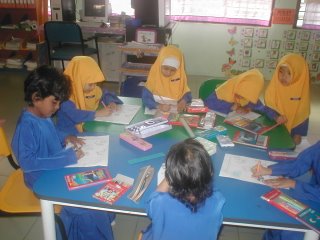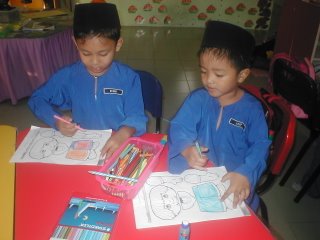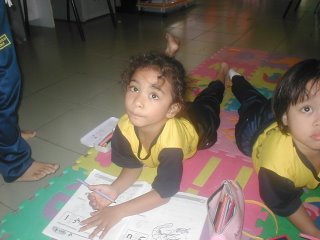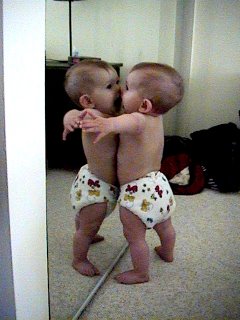Child Development
Child development provides parents with information on physical, mental and emotional growth and development in children. Child development information can help parents know when they are expecting too much from a child as well as become aware of lags in development that may benefit from professional help.
Tuesday, August 29, 2006

Good teachers of young children posses many attributes and characteristics. A review research by Feeney and Chun (1985) found that the best teachers of young children exhibited the following characteristics:
Warmth
Sensitivity
Flexibility
Honesty
Integrity
Naturalness
A sense of humor
Acceptance of individual differences
The ability to support growth without being overprotective
Physical strength
Vitality
Compassion
Self-acceptance
Emotional stability
Self-confidence
The ability to sustain effort
The ability to learn from experience ( Hymes, 1968; Read & Patterson,1980; Yardley,1971)
posted by Fauziah at
11:11 PM
0
comments

Children experience many stressful life events that threaten their healthy development, physical safety, and psychological well-being. Violence, homelessness, sexual abuse, death, divorce, and questions about these stressors are common for young children. Knowing about children’s cognitive level of understanding of stressors and their emotional responses to them will help teachers use developmentally appropriate communication and activities that can facilitate sharing of information, reduction of emotional distress, and development of effective coping strategies. Children’s book, art, and play support children’s emotional expression and stress management and reduction. A psychologically safe and physically safe classroom, and teachers who respond with information and reassurance, can help children develop thrust and resiliency to enhance their ability to thrive in contemporary society.
posted by Fauziah at
11:01 PM
0
comments

Monday, August 28, 2006

Play is vital to the development of all facets of the young child’s emerging self. Play supports children as they develop independence and achieve mastery and control over their environment. Through play, children invent, explore, imitate, and practice the routines of everyday living as a step in the development of self-help skills. The successful acquisition of these skills promotes children’s feelings of competence. Their emerging independence fosters the ability to make choices about everyday decisions, such as which book to read or whether to paint, play with dolls, or built with blocks. Children who are given opportunities to explore and experiment with non-stereotypical roles and behaviors are more likely to perceive a diverse range of personal and professional roles as possible options. When children enact a variety of roles through pretend play, they are more likely to see many possibilities for themselves and to make more informed decisions about choices available to them.
Play promotes the development of personal awareness in the following areas:
- Self-help skills
- Independence
- Personal health
- Personal safety
Play promotes the development these facets of emotional well-being:
- Awareness, acceptance, and expression of emotions.
- Coping skills.
- Personality intergration.
- Building values.
Play promotes the development of socialization in the following areas:
- Social interactions.
- Cooperation
- Conversation
- Respect for other
Play promotes the development of the facets of communication:
- Receptive language
- Expressive language
- Nonverbal communication
- Auditory memory / discrimination
Play promotes the development of cognition:
- Problem solving
- Concept formation
- Imitation / memory
- Association / classification
Play promotes the development of perceptual motor skills:
- Eye-hand / eye-foot coordination
- Locomotor skills
- Non-locomotor skills
- Body management and control
posted by Fauziah at
8:38 PM
0
comments

Sunday, August 27, 2006

For every good book you discover, you may wade through a stack that makes you wonder whether the authors have any experience at all with young children. Remember, appropriate material for a four-year-old may not suit a younger child. Each book you select may have one or more of the following desirable and valuable features:
- Characterization
- Colour
- Fantasy
- Surprise
- Repetition
- An example of human courage, cleverness, or grit
- Aesthetic appeal
- Listening pleasure
- A game-like challenge
- Suspense
- Humor or wit
- Hope
- Charm
- Sensitivity
- Realistic dialogue
- Cultural insight
- Nonsense
- Action
- Predictability
- Onomatopoeia ( the naming of thing or action by a vocal imitation of the sound associated with it, as in buzz and hiss )
Illustration help give words reality. For young children, illustrations promote visual literacy. Additional benefits are:
- Provision of pleasure
- Promoting of creative expression
- Development of imagery
- Nourishment of the imagination
- Presentation and exploration of a variety of styles and forms for the communication of ideas.
- Awareness of functions of languages
- Acquisition of the metalinguistic awareness ( defines as a sense of what printed language is all about )
The following is a series of questions you could use when choosing a child’s book:
1. Could I read this book enthusiastically, really enjoying story?
2. Are the contents of the book appropriate for my child?
a) Can my child relate some parts to his/her lives and past experience?
b) Can my child identify with one or more of the characters?
- look at some children’s classic such as Mother Goose. Almost all of the stories have well-defined character with whom children have something in common.
c) Does the book have directly quoted conversation? If it does, this can add interest; for example “Are you my mother?” he said to the cow.
d) Will my child benefit from attitudes and models found in the book?
e) Was the book written with an understanding of my child age level characteristic?
- Is the text too long to sit through? Are there to many words?
- Are there enough colourful or action-packed pictures or illustration to hold attention?
- Is the size of the book suitable for easy handling for viewing?
- Can my child participate in the story by speaking or making actions?
- Is the fairy tale or folktale too complex, symbolic, and confusing to have meaning?
f) Is the author’s story enjoyable?
- Is the book written clearly with vocabulary and sequence my child’s understand?
- Are repetitions of words, actions, rhymes, or story parts used?
- Does the story develop and end with a satisfying climax of events?
- Are there humorous parts and silly names? The young child’s humor often slapstick in nature (pie-in-the-face, all-fall-down type rather than play on words).The ridiculous and farfetched often tickle them.
g) Does it have educational value?
h) Do pictures explain and coordinate well with the text?
posted by Fauziah at
8:50 PM
0
comments


1. Activities using mirrors.
2. Activities using children’s photographs and home movies.
3. Activities that indentify favorite pursuits, objects, or individual choices.
4. Activities that build pride or membership in a group
5. Activities that show both similarity to others and individual diversity.
6. Activities concerns with personal opinions.
7. Activities that identify and discuss feelings.
8. Tracing of the child outline.
9. Making nametags and placing names on belongings, drawing, lockers and projects.
posted by Fauziah at
7:28 PM
0
comments


Knowing typical and common language development characteristics helps the teacher understand that children are unique individuals. Rapid growth of vocabulary and language skills is part of normal growth. Errors in the speech of young preschoolers make verbalizations partly understandable. Key words in the correct order give adults clues to what’s intended. Self-talk during the child’s play usually describes what the child is doing and may alternate with social comments.
Teachers can use their knowledge of early childhood language development in many ways, such as alerting the staff about a child’s need for hearing tests or special help and helping parents who are concerned with their child’s speech patterns.
Older preschool children have to almost adult-like speech. They explore words and begin to understand their power. Fantasy play peaks accompanied by speech. Some newly learned speech may be irritating to school staffs and parents, but it can indicate enjoying books occupies more of the children’s time. Exploring the real and make-believe words with words becomes children’s active pursuit during the early childhood years.
There is no ”average” child when it comes to language development; individual differences exist and are treated with acceptance and optimism.
posted by Fauziah at
7:26 PM
0
comments

Emerging Literacy in the Young Learner
Language ability grows at its fastest rate of development during the toddler period. Young children accomplish difficult language tasks. They learn their native language sounds and successfully produce an increasing number of sounds. Grammar rules form and reform as the child get closer to reproducing mature speech patterns. The child listens more carefully, noticing regularities and meanings of words and gestures.
Concepts develop, serving as categories that help the child organize life’s events. Many concepts are paired with words. Word symbols aid communication and language by allowing the child to speak and to understand. Parents’ conversations and the child’s firsthand exploration through sense organs give depth to new words.
Toddlers are active in conversation, speaking and listening, sometimes correcting, trying to get the message across to whoever in the family will listen. Toddlers talk to themselves and their toys in one and then two (for more) word sentences. These sentences are barely recognizable at first but gain more and more clarity as children age.
Differences between children’s speech output may noticed, and responsive, sensitive adult are language promoting companions. Toddler books are enjoyed and plentiful.
posted by Fauziah at
6:38 PM
0
comments


Each child grows in language ability in a unique way. The process starts before birth with the development of sensory organs. Parents play an important role in a child’s growth and mastery of language.
Perceptions gained through life experiences serve as the base for future learning of words and speech. Babbling, sound making, and imitation occur, and first words appear.
A number of related factors influence a child’s language acquisition. Most children progress through a series of language ability stages and milestones at about the same ages and become adult-like speakers during the preschool period. The way children learn language is not clearly understood, and so there are a number of differing theories of language acquisition.
Early in life, infants and parents form reciprocal relationship reacting in special ways to each other. The quality and quantity of parental attention becomes an important factor in language development.
The child progresses from receiving to sending language, which is accompanied by gestures and nonverbal communication. From infancy, the child is an active participant, edging closer to the two-way process required in language usage and verbal communication.
Staff members in infant-care programs can possess interaction skills that offer infants optimum opportunities for speech development.
posted by Fauziah at
4:48 PM
0
comments

Friday, August 25, 2006
 Read to him/her - lots of different stories, poems and rhymes. Let him see your finger following the text. Ask questions about the story and pictures. Let him join in where possible. Children are never too old to enjoy and benefit from listening to written language. Talk - and listen to your child, even when the question is one you've heard a million times. Help your child hold the pencil properly. Sit next to him when you write, not opposite. If he is left handed and you are not, let him see you write with your left hand - otherwise he can't copy what you do. (The opposite also applies). Praise your child at every opportunity. The more he feels successful, the more he'll want to practice; and the better he'll get. Don't transfer any worries onto your child. Be relaxed. Have fun! Don't work when one of you is tired, hungry or bored. Remember - happy learners learn FAST. Your main aim should be to help your child be happy while learning. Resource: http://childliteracy.com/tips.html
posted by Fauziah at
11:17 AM
0
comments

 Pre-reading skills are the skills children need before they can learn to read. Many of these skills are learnt naturally, during the course of a normal childhood and nursery environment. By talking and reading to your child, you will be doing a great deal to develop these essential skills. It does help if you know what you are doing, though, so that you can make the best use of your child's natural inquisitiveness during the pre-school years. Prereading skills: Matching - When we read, part of what we do involve matching. Children learn to match shapes, patterns, letters and, finally, words. Rhyming - Research shows that children who can understand about rhyming words have a head start in learning to read and, even more, to spell. Letter skills - As well as looking at letters, children need to learn what sounds the letters can make. Direction - Print goes from left to right. We know that but children need to practice it (especially left-handed children). Motor skills - Since reading and writing are best taught together, pencil control is important. Concepts of print - This really means 'how we look at books'. Following print the right way, turning the pages, looking at pictures, 'where are the words...?' Language skills - The more experience children have of language, the more easily they will learn to read. Your child needs to hear and join in conversations (with adults and children), and listen to stories and poetry of all sorts.
posted by Fauziah at
11:01 AM
0
comments


In early writing, we can expect lots of talk to surround writing, since what children are doing is figuring out how to get speech onto paper. Early teaching in composition should also attend to helping children get used to producing language orally, through telling stories, explaining how things work, predicting what will happen, and guessing about why things and people are the way they are. Early writing experiences will include students explaining orally what is in a text, whether it is printed or drawn.
As they grow, writers still need opportunities to talk about what they are writing about, to rehearse the language of their upcoming texts and run ideas by trusted colleagues before taking the risk of committing words to paper. After making a draft, it is often helpful for writers to discuss with peers what they have done, partly in order to get ideas from their peers, partly to see what they, the writers, say when they try to explain their thinking. Writing conferences, wherein student writers talk about their work with a teacher, who can make suggestions or re-orient what the writer is doing, are also very helpful uses of talk in the writing process.
To take advantage of the strong relationships between talk and writing, teachers must minimally understand:
• Ways of setting up and managing student talk in partnerships and groups.
• Ways of establishing a balance between talk and writing in classroom management.
• Ways of organizing the classroom and/or schedule to permit individual teacher-student conferences.
• Strategies for deliberate insertions of opportunities for talk into the writing process: knowing when and how students should talk about their writing.
• Ways of anticipating and solving interpersonal conflicts that arise when students discuss writing.
• Group dynamics in classrooms.
• Relationships -- both similarities and differences -- between oral and literate language.
• The uses of writing in public presentations and the values of students making oral presentations that grow out of and use their writing.
posted by Fauziah at
10:36 AM
0
comments

Tuesday, August 22, 2006

It's important to remember that writing, spelling and reading are all inextricably linked together. Good writers, are good spellers are good readers. Reading encourages good spelling and writing. When reading, children use their knowledge of letters, sounds, and context to work out what words say. When writing, children draw on knowledge they have gained from reading - often children will construct a story with a similar structure and storyline to one they have already read. This helps them learn the structure of a story (beginning, middle, end), which kinds of details need to be included in the story (characters, locations, context) and which order it needs to go in (sequence). Typically young children start writing 'stories' as a single sentence. As the child gains more skills, their stories become increasingly complex. Writing stories also gives children an opportunity to use their spelling skills in context. Children need to know how to spell using the conventional spelling of words, so that an audience (parent, teacher or other student) can read their work. This alone can be a great incentive for children to get the spelling right.
posted by Fauziah at
7:56 AM
0
comments

 Watching children develop the skills of learning to write is a fascinating process. In writing sessions I had with my 5 - 8 year olds, I could literally see their minds ticking over with the learning they were experiencing. And to see them realise and understand their achievements, which I would point out to them, was a really special thing to witness. In the past It was typical that students would write once a week, on a topic given to them by the teacher, who allowed a certain amount of time for the task to be completed in. The teacher would correct it in red pen and give it back to the student. Now In a lot of schools, teachers have replaced the above approach with an exciting and meaningful process. Children are encouraged to develop their own stories, to become authors who express their own ideas and fantasies in their writing. The children then 'publish' their work and present it to the class as something they can be proud of. It's very much a partnership between the teacher and the student. This information has been sourced from the book "Parents, Teachers, Partners" by Barry Dwyer.
posted by Fauziah at
7:34 AM
0
comments

|


|
















